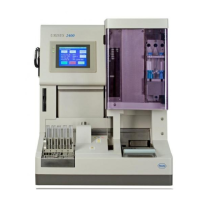Roche Diagnostics
C-36 Operator’s Manual · Version 1.0
6 Special operations URISYS 2400
Calibration
Calibration
The operator can calibrate the photometer and the SG (specific gravity) meter
using the [User Calibration] screen.
Photometer calibration is based on the measurement of a calibration strip
with known reflectance specifications. This must only be performed using the
URISYS 2400 calibration strip manufactured by Roche Diagnostics.
Specific gravity calibration is based on the measurement of calibration
solutions of known refractive indices.
Under routine conditions, calibrate the photometer and the SG meter every
four weeks.
Photometer calibration
The calibration values measured for each elevated area of the calibration strip
are compared with the previous user calibration values measured and the
factory calibration values.
If the calibration values are within ±2% of previous values, and within ±5% of
the factory values, “Calibration OK” is displayed on the [Photometer
Calibration] screen and the previous user calibration values are replaced.
If the calibration values differ by more than ±2% from previous values, or
more than ±5% from factory values, “Calibr. Failed” is displayed on the
[Photometer Calibration] screen and the calibration must be repeated.
Handle and store the URISYS 2400 calibration strips according to the
instructions in the calibration strip package insert.
The calibration strip is made of grey plastic material of constant reflectance
characteristics. It has nine elevated areas on the upper side, and three feet on
the underside. The two outer feet fix the strip on the lateral sides of the TS
Calibration procedures are only possible when the analyzer is in Stand-By status.
Sample testing can only start when photometer calibration is successful. If
calibration failed after several attempts, contact Technical Support.

